Zebra Grass
- March 19, 2024
- 0 comment
Zebra Grass, also called Miscanthus sinensis ‘Zebrinus’, is a type of plant that stands out because of its stripes that look like a zebra’s pattern. This grass is loved by many gardeners and landscapers because it adds a special touch to any garden or outdoor space. It’s easy to take care of, which means you don’t have to spend a lot of time looking after it.

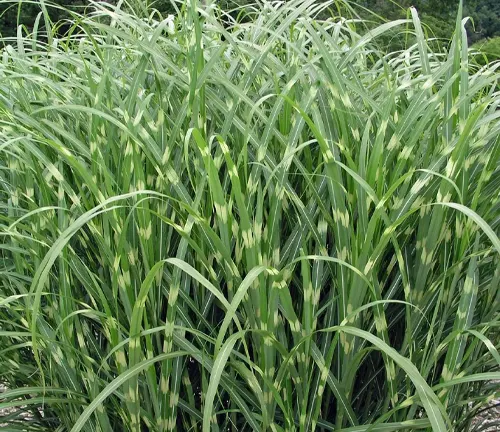
If you want to enhance your garden with Zebra Grass, make sure to plant it in a sunny spot with well-draining soil. Water it regularly, especially during dry spells, and trim it back in late winter or early spring to keep it looking neat. With its unique stripes and low maintenance needs, Miscanthus sinensis ‘Zebrinus’ can bring a touch of the wild to your garden without much effort.
| Characteristics | Description |
| Scientific Name | Miscanthus sinensis ‘Zebrinus’ |
| Common Names | Zebra Grass, Maiden Grass |
| Family | Poaceae |
| Native Region | Eastern Asia, including China, Japan, and Korea |
| Plant Type | Ornamental grass |
| Size | Can grow up to 4-7 feet in height and 3-5 feet in width |
| Leaves | Long, arching leaves with horizontal golden stripes |
| Flowers | Pink or coppery plumes in late summer to fall |
| Propagation | Typically propagated through division in spring |
| Drought Tolerance | Moderately drought-tolerant once established |
| Cultural Uses | Ornamental grass in gardens, landscaping, and erosion control |
| Ecological Role | Provides habitat and food for wildlife, aids in erosion control |
| Notable Species | Other notable species in the Miscanthus genus include Miscanthus giganteus and Miscanthus sinensis ‘Gracillimus’. |
| Hardiness Zones | It thrives in USDA hardiness zones 4 through 9 |
| Growth Rate | Zebra Grass has a moderate to fast growth rate |
| Lifespan | As a perennial, it can live and thrive in the garden for several years with proper care |
Botanical Beauty of “Zebra Grass ”
Zebra Grass is celebrated for its botanical beauty, characterized by its striking foliage and graceful plumes. The golden horizontal stripes on the leaves create a visually captivating effect, especially when swaying in the wind. The feathery pink or coppery plumes that emerge in late summer add an ethereal quality to the plant, making it a standout feature in any landscape.

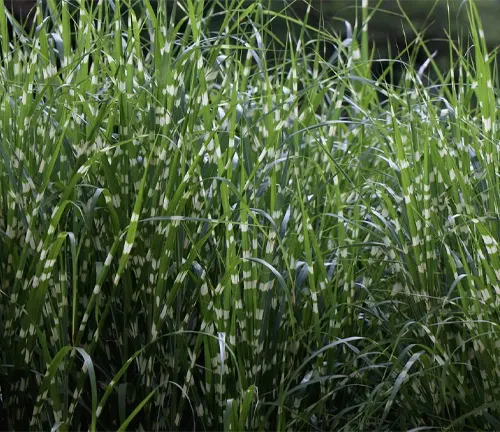
Woodland Elegance
Zebra Grass exudes a sense of woodland elegance, evoking a natural and tranquil ambiance in gardens and landscapes. Its tall and swaying nature lends a sense of movement and grace, making it a preferred choice for adding vertical interest and softening hardscapes.
Ecological Importance
In addition to its ornamental value, Zebra Grass plays a crucial ecological role. It provides shelter and nesting sites for birds, while its seeds serve as a food source for various wildlife species. Furthermore, its extensive root system contributes to soil stabilization, preventing erosion in landscapes.
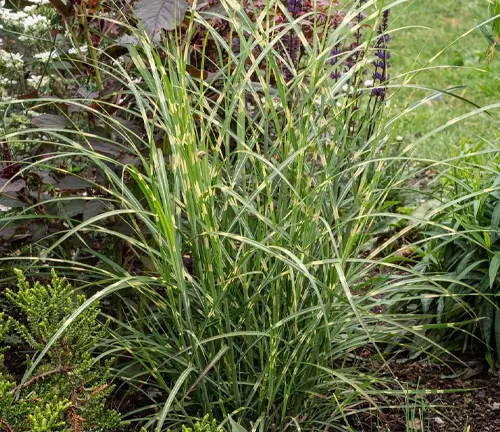
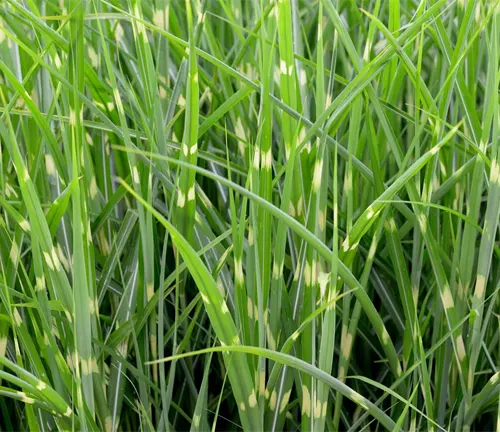
Cultivation and Conservation
Zebra Grass is relatively easy to cultivate, thriving in well-drained soil and full sun to partial shade. It is a low-maintenance plant that requires minimal intervention once established. Due to its adaptability and ornamental appeal, efforts to conserve and protect its natural habitats are essential for preserving the biodiversity of the regions where it is native.
Fragrance
Zebra Grass, despite not having a strong smell, is a popular choice for gardens and landscapes because of its striking appearance and easy upkeep. While it may not fill the air with fragrance, its unique zebra-like stripes make it visually appealing and sought after by many garden enthusiasts. This grass is favored for its beauty and the fact that it doesn’t require a lot of maintenance, making it a great addition to any outdoor space.
When incorporating Zebra Grass into your garden, remember that its charm lies in its looks rather than its scent. This plant thrives in sunny areas with well-draining soil, making it a versatile option for various garden settings. Although it may not emit a fragrance, its distinct striped foliage can create a captivating focal point in your landscape. With minimal care needed, this plant offers an easy way to enhance the aesthetic appeal of your garden.
Soil Stabilization
Zebra Grass is a helpful plant for keeping soil in place because of its strong roots. These roots go deep into the ground, helping to stabilize the soil and prevent erosion. This makes Zebra Grass a good option for areas like slopes or places where the soil easily shifts. By planting Zebra Grass in these spots, you can help stop soil from moving and protect your landscape.
When you want to use Zebra Grass to stabilize soil, look for places where erosion is a problem, such as slopes or areas with loose soil. The tough root system of this grass will work to hold the soil in place and reduce the chances of erosion. By planting Miscanthus sinensis ‘Zebrinus’ strategically in these areas, you can create a natural barrier that stops soil movement and keeps the land stable.
Common Uses
Zebra Grass is a popular choice for adding beauty to different outdoor areas like home gardens, public parks, and commercial landscapes. Its eye-catching look and easy upkeep make it a great option for enhancing the visual appeal of these spaces. Whether you want to add texture to your backyard, create a welcoming atmosphere in a park, or spruce up a commercial property, Zebra Grass can be a versatile and attractive addition.
Benefits
Zebra Grass offers multiple benefits for landscapes, starting with its ability to add visual interest and texture. With its unique zebra-like stripes, this grass can create a striking focal point in gardens and outdoor spaces. Once established, Miscanthus sinensis ‘Zebrinus’ is low maintenance and can withstand drought conditions, making it a practical choice for busy gardeners or areas with limited water availability.
Additionally, Zebra Grass serves as more than just a decorative plant; it provides habitat and food for wildlife, supporting biodiversity in the ecosystem. Furthermore, its strong root system aids in soil stabilization and erosion control, making it a valuable asset for maintaining the integrity of landscapes and preventing soil movement. Overall, Miscanthus sinensis ‘Zebrinus’ offers a combination of aesthetic appeal, environmental benefits, and practical functionality for various outdoor settings.
Different Species
Miscanthus sinensis ‘Gracillimus’
Known as Maiden Grass, it features fine, narrow foliage that forms a graceful, arching mound. The leaves turn golden in the fall, and it produces silvery plumes.

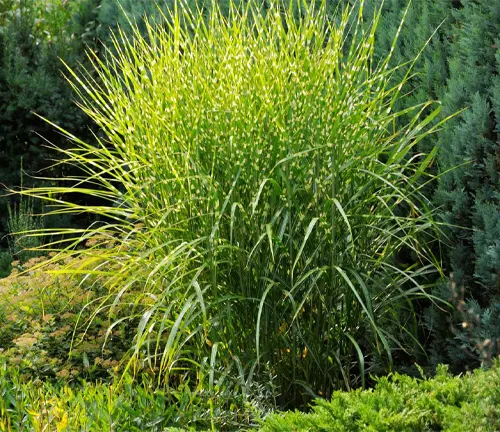
Miscanthus sinensis ‘Strictus’
Often confused with ‘Zebrinus’, this cultivar, known as Porcupine Grass, has more upright growth and horizontal bands similar to ‘Zebrinus’ but with a more rigid form.
Miscanthus sinensis ‘Variegatus’
This variety boasts vertically variegated leaves, with white stripes running along the length of the green foliage, offering a lighter appearance.
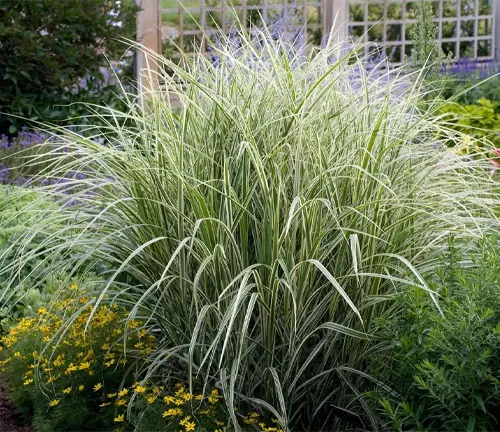
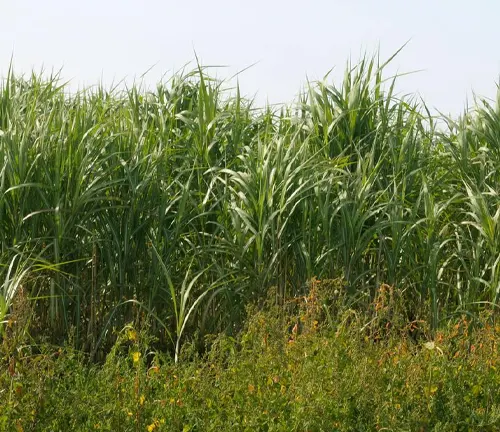
Miscanthus giganteus
As its name suggests, Giant Miscanthus is a tall species that can reach heights of up to 14 feet. It is used both as an ornamental grass and for biomass production.
Miscanthus sinensis ‘Morning Light’
This cultivar is appreciated for its fine-textured foliage with white variegated margins, giving it a silvery appearance from a distance.
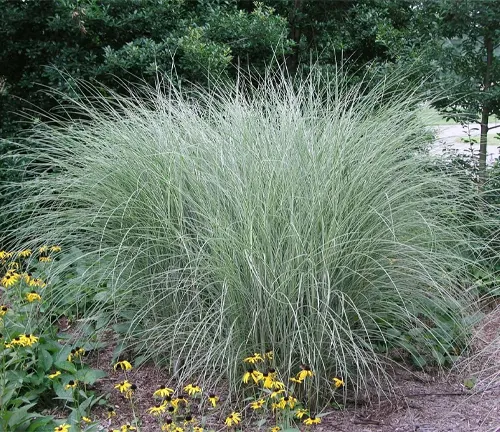
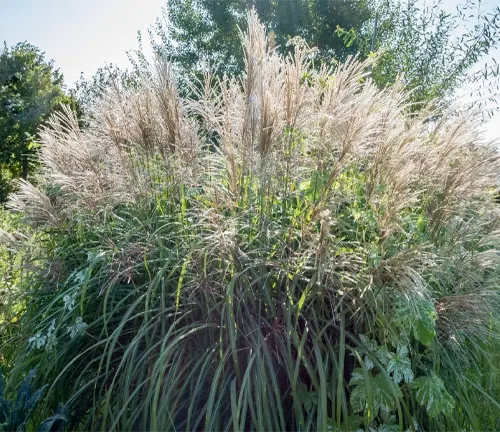
Miscanthus sinensis ‘Silberfeder’
Known as Silver Feather Grass, it is valued for its large, feathery, silver plumes that appear in late summer and last into winter.
Miscanthus sinensis ‘Kleine Silberspinne’
Translating to “Little Silver Spider”, this smaller cultivar features narrow leaves and compact growth, making it suitable for smaller gardens.

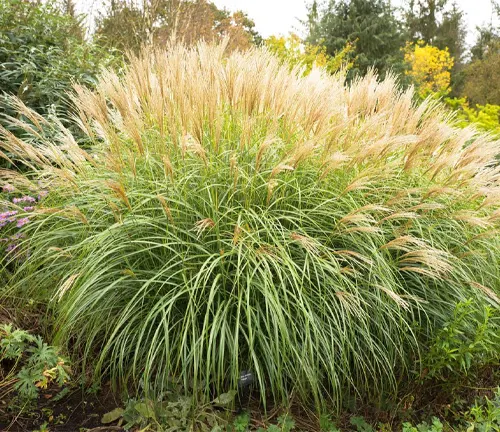
Miscanthus sinensis ‘Adagio’
A dwarf variety that offers fine, silvery-grey foliage and pinkish flower plumes that mature to white.
Frequently Asked Questions (FAQs)
1. What is Zebra Grass?
Zebra Grass is a plant known for its unique green leaves with horizontal golden stripes, resembling a zebra’s pattern. It’s an easy-to-care-for grass that adds a special touch to gardens.
2. Where does Zebra Grass come from?
Zebra Grass is native to Eastern Asia, including countries like China, Japan, and Korea. It’s used worldwide in gardens for its beauty and ease of care.
3. How tall does Zebra Grass grow?
Zebra Grass can grow up to 4-7 feet tall and spread 3-5 feet wide, making it a noticeable addition to any landscape.
4. Does Zebra Grass flower?
Yes, it produces pink or coppery plumes in late summer to fall, adding another layer of beauty to its striking foliage.
5. How do you propagate Zebra Grass?
The best way to propagate Zebra Grass is by dividing its rootball in spring. This helps the plant spread and thrive in your garden.
6. Is Zebra Grass drought-tolerant?
Once established, Zebra Grass is moderately drought-tolerant, making it a resilient choice for various garden settings.
7. What are the common uses of Zebra Grass?
Zebra Grass is widely used for ornamental purposes in gardens, landscaping, and for erosion control thanks to its striking appearance and ecological benefits.
8. Can Zebra Grass help with soil erosion?
Yes, its strong root system helps stabilize the soil, making it an excellent choice for preventing erosion, especially on slopes or in areas prone to soil movement.
9. What are the benefits of planting Zebra Grass?
Zebra Grass is low maintenance, drought-tolerant, and adds visual interest to landscapes. It also supports wildlife and helps control soil erosion.
10. Are there different types of Zebra Grass?
While “Zebra Grass” specifically refers to Miscanthus sinensis ‘Zebrinus’, there are other Miscanthus species and cultivars with varied sizes and appearances, such as ‘Gracillimus’, ‘Strictus’, ‘Variegatus’, and ‘Giganteus’, each offering unique characteristics for gardeners to choose from.


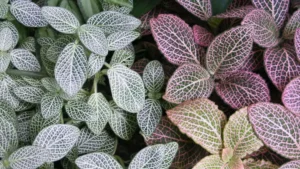
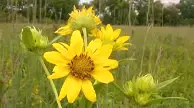


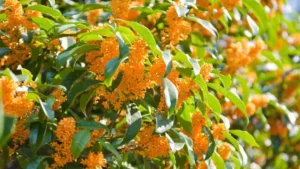

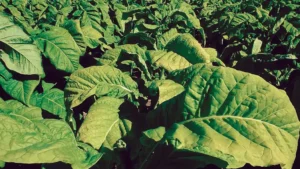
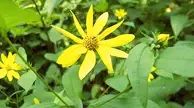
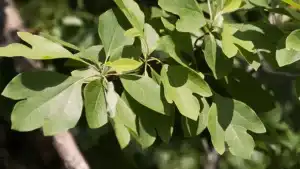

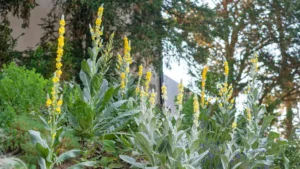
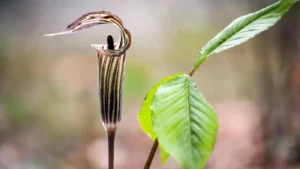
Leave your comment